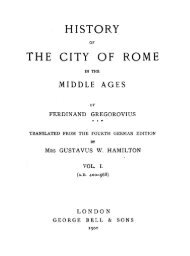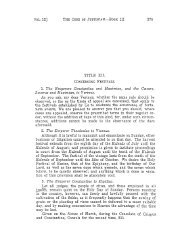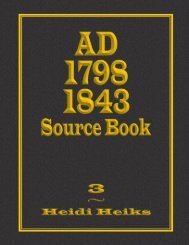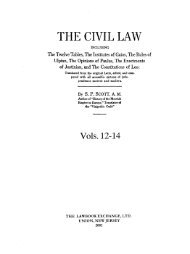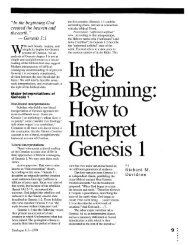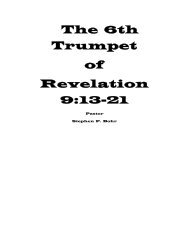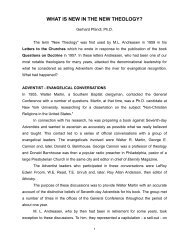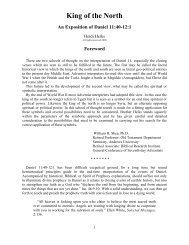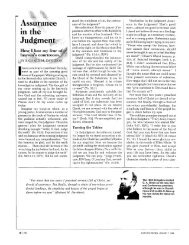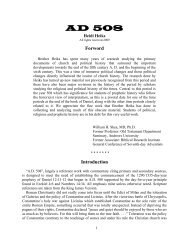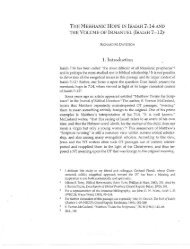You also want an ePaper? Increase the reach of your titles
YUMPU automatically turns print PDFs into web optimized ePapers that Google loves.
<strong>Judgment</strong> <strong>in</strong> <strong>Daniel</strong> 7A certa<strong>in</strong> amount ofpoetic balance may be seen <strong>in</strong> chapter 7 when itsthree poetic passages orstanzas are compared. Ifthebicola ofthe first twostanzas are added together, they are seen to nearly equal the bicola ofthisthird stanza (10 bicola: :8 bicola and 1 tricolon). Furthermore, the first sixbicola ofthe third stanza (vss. 23-25) equal the six bicola ofthe first stanza(vss. 9-10); and the two bicola and one tricolon ofthe third stanza almostequal the four bicola of the second stanza (vss. 13-14).The consecutive order of this narration outl<strong>in</strong>ed <strong>in</strong> the third stanza isemphasized by the cont<strong>in</strong>uous use of the imperfect form of the verbsthroughout (vss. 23-27). Follow<strong>in</strong>g the <strong>in</strong>troductory perfect, which putsGabriel's speech <strong>in</strong> past time, 18 imperfects appear <strong>in</strong> the consecutivecourse ofthis narration. The three <strong>in</strong>f<strong>in</strong>itives <strong>in</strong> it take their time referencefrom the imperfects with which they are l<strong>in</strong>ked. This use ofthe imperfectas the narrative verbal form for the description offuture actions stands <strong>in</strong>contrast with the "prophetic perfects" found <strong>in</strong> <strong>Daniel</strong>'s description ofhisvision as mentioned above <strong>in</strong> the analysis of the two preced<strong>in</strong>g stanzas.In addition, a dozen perfects appear <strong>in</strong> the narration ofthe vision thatruns from verse 2 to verse 8, along with three more compound verbal constructionsexpress<strong>in</strong>g past time. This frequency stands <strong>in</strong> contrast with thethree participles, two imperatives, and one imperfect that are found <strong>in</strong> theprose passage. Thus chapter 7 presents a dist<strong>in</strong>ct differentiation-analmost classical <strong>in</strong>stance-of the use oftenses to prophesy future events.The perfect is used to narrate its vision, and the imperfect is used to narrateits <strong>in</strong>terpretation. The synthetic nature ofvirtually all the parallelismsemployed <strong>in</strong> the bicola also emphasizes the consecutive order ofits narration.The first bicolon of the couplet deal<strong>in</strong>g with the fourth k<strong>in</strong>gdom (vs.23) beg<strong>in</strong>s and ends with the word "k<strong>in</strong>gdom." (Literally, "K<strong>in</strong>gdom, thefourth, shall be on the earth which shall be different from all the k<strong>in</strong>gdoms.")The verbal construction of the second bicolon <strong>in</strong> the same verse emphasizesthe <strong>in</strong>tensive nature of the destructive actions of this k<strong>in</strong>gdoms<strong>in</strong>ce three verbs ("consume," "trample," "crush") appear <strong>in</strong> its two cola.A pair of them are l<strong>in</strong>ked together <strong>in</strong> its second colon ("shall trample ...and crush"). This construction is of<strong>in</strong>terest when it is noted that the samearrangement occurs only <strong>in</strong> verse 26 where theangel states how thoroughlythe judgment will dispose of the k<strong>in</strong>gdom of the little horn ("shall takeaway," "destroy," "annihilate").Another observation on the verbs ofthe second bicolon <strong>in</strong> verse 23 is128



